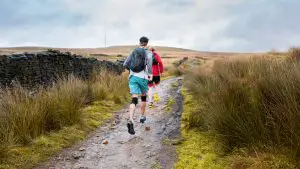What Age Can You Take a Puppy on A Hike

Getting your dog out onto the trails with you can be quite an exciting experience for both pup and owner! Dogs can be an especially excellent companion to take with you on your outdoor hiking adventures, but making sure they’re prepared for all that hikes require out of you is something you need to take into consideration before taking your pet on the trails with you, especially if you plan to take a puppy with you.
Quick Links
Puppy Growth-Plate Injuries Explained
The younger your fur baby is, the more likely it is that they’ll just be a fiery ball of energy wanting to explore, sniff, lick, and pee on everything they come across. This isn’t necessarily a bad thing, however, all that wild puppy energy can be quite beneficial for younger pups on longer, steeper hikes. During the first year of your puppy’s life, everything is growing and developing rapidly, just like any other youngling of any kind of species.
With dogs specifically, they have these ligaments called growth plates that are located at the end of their bones. These growth plates are very soft when dogs are first born and need very gentle care to see that they harden properly as they mature out of puppyhood.
While they are still young, puppies are far more susceptible to injuring these important growth plates if they engage in strenuous activity that is not appropriate for their age. Long hikes up rigorous mountainsides have great potential to cause significant damage to a puppy’s growth plates, which later on result in long-term health complications as they mature.
The most common signs that your pup has a growth plate abnormality is if they exhibit signs of limping, swelling, or any abnormal growths on the limbs. If you begin to notice any of these symptoms in your puppy, take them to the vet immediately to prevent any further damage.
What Age Can You Start Hiking with A Puppy?
The vet should in fact be your first stop before you consider taking your puppy on a hike. As to not put your young puppy at risk of developing growth plate complications, always make sure to check in with your vet to make sure they are of an appropriate age and physical fitness to go on the hike.
The general rule of thumb is that you should wait at least a year, or 18 months for bigger breeds, to have them engage in any rigorous physical activity such as hiking.
But if you are really keen on taking your young pup out on the trails with you, despite their growth plate not being fully developed, we strongly recommend taking your puppy out in a backpack carrier.
This will give your puppy plenty of downtime to rest while you’ll still be able to get the most out of your hike.
Tips on How to Get Your Puppy Trail Ready
We understand that it can be a really exciting time to have a puppy come into your life. You’re probably just as eager as them to see all the world has to offer together, but remember that your puppy is still a baby, and you should be mindful to be gentler with them when you’re first introducing them to the joys of hiking.
Start Small
To get them used to walking longer distances, start your young puppy on several short hikes that are on flat ground. This will help increase their stamina and get their muscles ready to take on more intense hikes. Keep in mind that you should be especially gentle with dogs under the age of 18 months. Don’t push them too hard, as overexertion could put them at risk for developing growth plate abnormalities.
Don’t Jog Yet
Jogging with your puppy might seem like a great way to get them used to the pace of hiking, but at this young age, it’s not recommended. Their little legs are still growing and developing, and the impact from running could potentially damage their growth plates.
Make Sure Your Puppy Is Adequately Trained
Before you take your puppy out on the trails, they should be able to respond to basic commands. Come, Sit and Stay should be easy commands for your puppy to obey before considering taking them out on a hike. Your puppy should also be able to display adequate impulse control, as this can help them not try to take a chunk out of the local wildlife or trail off to who knows where into the shrubbery. These skills are extremely important not only for the safety of your dog but for the other hikers and other forms of wildlife you might come across on the trails. Make sure to test their obedience levels before taking them hiking. You can do this yourself, or you can hire a dog trainer to make sure your puppy behaves civilly and politely.
Get Them Accustomed to Socialization
Ideally, your puppy should be used to seeing other people and other dogs. This will make for a very pleasant hiking experience not only for you and your pup but for the other people and other dogs you may come across. Nobody appreciates an unnecessarily aggressive dog, so your dog should be comfortable being around and interacting with other dogs.
This is especially important if you plan to have your dog off their leash on the trails, as you may come across young children on your hike. However, most hiking trails will require your dog to be ON a leash. Nevertheless, in this case, you want to make sure that your pup is going to be as gentle and as patient as they can be.
Gauge Their Fitness Level
Be honest about where your puppy is in terms of their physical fitness. Do they have the leg length to climb up steep mountains? What about the muscle strength to hike several miles in a day? Be considerate of your breed’s physical limitations, as well as the limitations your puppy faces because of their young age. If you’re unsure about how to do this properly, it’s always a good idea to get a second opinion from your vet.
Make Sure They’re up To Date on All Their Shots
Your puppy is potentially at risk for contracting certain viruses on the hike, especially rabies. To protect your young dog from contracting any diseases, or potentially passing them on to other dogs or humans out on the trail, make sure they’ve had all the required vaccinations to make sure everybody is as protected from disease as possible.
Once your puppy’s growth plates have settled, they’ve mastered commands as well as how to behave on and off a leash, you can now take the next step in taking your puppy on the big dog hikes.
Taking Your Puppy Hiking in A Puppy Backpack
If your pup is not quite ready to hit the trails with you, then it’s time to consider using a backpack.
This will help to ease your pup into the experience of hiking while also giving them a great vantage point to take in all the sights and smells.
You want to make sure that you get a backpack that fits your puppy well. It should be snug without being too tight and uncomfortable. You’ll also want to make sure that it has proper ventilation so that your puppy doesn’t overheat.
Here’s a great recommendation for a puppy backpack:

This puppy backpack by WOYYHO is made from a thick sponge and breathable mesh. Cleaning it is also a breeze as its parts are removable and washable. And lastly, it comes with great safety features, such as a built-in security leash and adjustable waist and chest buckles, with plenty of room for your puppy to move around and stay comfortable.
Some Things to Keep in Mind when Using a Puppy Backpack
Just because you are using a backpack, doesn’t mean you’ll be able to jump into challenging and long hikes right away. Here are some things to keep in mind while using a puppy backpack:
- Start small, with short hikes close to home.
- Let your pup get used to wearing the backpack by letting them wear it around the house for short periods of time.
- Put something familiar in the backpack, like a toy or their favorite blanket, to help make them feel more comfortable.
- Make sure to take plenty of breaks so your puppy can rest and get used to being in the backpack
What to Do Once You’re out On the Trail with Your Puppy
Take Your Pup on A Dog-Friendly Trail
Not every hiking trail is going to allow your furry friend to take in the natural splendor with you. Websites like alltrails.com can help you scout for the best hike for you and your puppy.
Remember to start out easy, as this will get your pup accustomed to the environment of hiking. Once they can conquer these less challenging trails, you can start to consider taking your puppy on more rigorous hikes. Just make sure that the growth plates in the puppy’s body are fully developed to prevent injury.
Keep Your Puppy Hydrated
To keep your puppy as happy and as motivated to finish the trail with you as possible, make certain to keep them well hydrated so they don’t tire out. It can also be very helpful to bring some puppy treats as further motivation to complete the trail, especially if you don’t plan to carry a tuckered-out pup all the way back home.
Recommendation: I recommend the MalsiPree Dog Water Bottle. It’s a portable water bottle that you can use to give your pup water on the go without having to stop and pour some out of a bowl. This is what we use, and it’s been a lifesaver on our hikes.
Bring Their Favorite Toys
Similar to children, puppies and dogs need to be kept entertained sufficiently, especially if you’re planning to take them out on longer hikes, or potentially even overnight trips. Bring one or two of their favorite toys with you on the hike. You may come across a beautiful open meadow that you can play fetch on.
Protect Their Paws
If you’re planning to hike in areas or seasons with more extreme weather, consider getting a pair of dog booties to keep their paws protected. Just like human hands and feet, dogs’ extremities can be very sensitive to hot surfaces and cold temperatures. Dog booties can also be helpful if you just want to keep your pup’s paws free of dirt and mud. Booties can also prevent foreign objects from inserting themselves into your pup’s paw pad.
Bring Poop Bags
All waste your puppy creates out on the trail should be picked up and properly disposed of. Waste on the trail can be disposed of with standard poop bags, or with the help of a small gardening shovel that can be used to dig small holes to bury the poop. Don’t be that person who leaves waste on the hiking trail!
Bring a First Aid Kit
This will not only be beneficial for your pup in case of any minor injuries, but this will also benefit you as well in the case of any scrapes, cuts, or splinters you may find yourself coming across on your trail. Be sure to include puppy-specific products in your first aid kit, as some products, such as sunscreen, can have a very adverse reaction when used on dogs.
Best Dog Breeds For Hiking
Generally, any dog can hike as long as they are healthy and physically able. Smaller breeds may have more difficulty hiking longer trails, but this doesn’t mean they can’t enjoy a good nature walk on a shorter looped trail. Some of the best dog breeds for hiking include:
Portuguese Water Dog
These dogs are very well suited to outdoor activities. The Portuguese water dog was originally bred to retrieve fishing nets from bodies of water, making dogs who have a good level of stamina. These amazing companions are happiest when they can get a lot of exercise, which makes them especially compatible hiking buddies.
German Shepherd
This breed is world-renowned for its loyalty, courage, and obedience. German shepherds are also very active dogs that need a lot of exercise to stay happy and healthy. They were originally bred as herding and working dogs, so they have a natural instinct to protect and serve. Taking your German shepherd on hikes with you will allow them to indulge in their natural scavenging and working instincts.
Labrador Retriever
These dogs are some of the most popular family pets for a reason. They are incredibly friendly, good with children, and have a lot of energy. Labrador retrievers were originally bred as working dogs on fishing boats and farms. They are natural swimmers and love to play fetch, making them ideal hiking companions.
Golden Retriever
This is another extremely popular family pet that makes a great hiking buddy. Golden retrievers are very friendly, obedient, and intelligent dogs. They were originally bred as hunting dogs, so they have a natural instinct to follow their nose. This breed loves spending time outdoors, making them the perfect hiking companions.
Poodle
This breed is often thought of as a “pampered pet,” but poodles are actually very active and athletic dogs. They come in three different sizes (standard, miniature, and toy), so there is a poodle size for every family. Poodles were originally bred as water dogs, so they love swimming and playing in the water. This makes them great hiking companions, especially in hot weather.
Alaskan Malamute
The Alaskan Malamute has been specially bred to stand long hours of extremely vigorous activity. Originally intended to pull sleds through the snow for long stretches of time, the stamina bred into this lively dog is sure to keep them on hikes that require more of a test of cardiovascular strength.
Siberian Husky
Speaking of little fiery balls of energy, there’s never a dull moment with a husky around. With an impressive amount of strength, these dogs have been known to haul over 1000 pounds on sleds through some of the most difficult terrains. They have high endurance and can run for miles, making them one of the best dog breeds for hiking.
Bernese Mountain Dog
An incredibly large and helpful breed of dog, these gentle giants were originally used to herd cattle on the mountainsides of the Swiss alps. Because of their history of service, the Bernese Mountain Dog is extremely well adapted to endure strenuous activity and is perfect for those hikes that require a bit more dexterity.
Australian Cattle Dog
Australian cattle dogs are a very athletic breed of dog. Originally herding dogs, these pups are full of energy, extremely alert, and have a great sense of balance. They also excel at obedience, which is an extremely crucial skill for a dog to have when potentially being off-leash in an outdoor environment.
Vizsla
The Vizsla was originally bred to be a hunting dog, which makes them incredibly well adapted to staying outdoors for extended periods of time. These dogs are extremely friendly and are wild balls of energy once outdoors. If you take a Vizsla on the trials with you, just make sure this dog has been properly trained, as their curious hunter instincts may get the best of them at times.
Conclusion
In conclusion, you can begin to introduce your puppy to very mild forms of hiking earlier on, however, you should wait at least 15 months before you begin to plan a big overnight backpacking trip with your pup. Overexerting your puppy too young could have very negative long-term consequences.
Take everything we’ve said about obedience, socialization, and even dog breed into consideration, and you can be sure that you and your puppy will create memorable moments together out on the trails!







